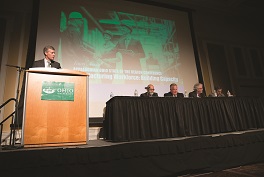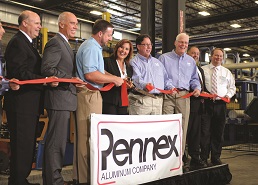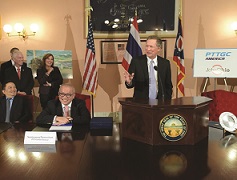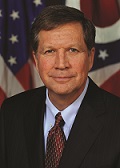

Ohio’s economy is on the rise. The state’s unemployment rate is well below the national unemployment rate, and Ohio incomes are improving compared to the rest of the nation, with wage growth exceeding the U.S. rate since the beginning of 2011. In addition to labor market improvement, Ohio’s gross state product has grown faster than the national gross domestic product since January 2011, and its share of the U.S. economy has increased during the last four years. Ohio is on solid ground and primed for long-term growth.
Ohio continues to succeed at helping businesses grow jobs and capital investment within the state by working with companies of various sizes. Large corporations have an established presence in the state’s key industries. Middle-market companies are creating the majority of the jobs and capital investment. Small businesses are innovators and will drive future job growth. About 85 percent of Ohio’s projects focus on small business and middle-market companies, accounting for almost 70 percent of the jobs and capital investment Ohio generates.
Foreign direct investment (FDI) plays a significant role in Ohio’s economy with more than 3,400 international establishments supporting more than 200,000 jobs. According to the U.S. Department of Commerce, Ohio ranks eighth in the United States for American employment by international firms. Building on Ohio’s global reputation for manufacturing strength, Ohio focuses considerable effort on extending opportunities for FDI. China, Germany and Japan are Ohio’s top target markets. Ohio is investing marketing resources in Germany, China and Japan to expedite project pipeline growth and broaden the state’s reach. This proactive sales strategy increased bandwidth for relationship-building with parent companies and subsidiaries, a cornerstone of Ohio’s attraction, retention and expansion strategy.

The American subsidiary of Fuyao Group, the largest exporter of automotive glass in China, will build its first North American automotive glass manufacturing facility in Moraine, adding more than 1,500 new jobs.
General Electric is building its U.S. Global Operations Center in Cincinnati, which is expected to create 1,400 jobs over the next five years.
The American subsidiary of PTT Global Chemical, Thailand’s largest integrated petrochemical and refining company, is ready to invest $100 million to conduct detailed engineering design for a world-scale cracker facility on a site on the west bank of the Ohio River in Belmont County.
Amazon has committed to developing facilities in Ohio for its Amazon Web Services cloud as well as facilities such as fulfillment centers to support its other businesses, and plans to create several $100 million in investment and more than 1,000 jobs in the state over the next few years.
Alliance Data, one of the largest providers of branded credit card programs in the nation, plans to expand and consolidate its Columbus operations at a new office campus where it will add 700 jobs.
McLane, one of the nation’s leading wholesale suppliers to grocery retailers and restaurants, has committed to create 425 jobs and invest $119 million at a new distribution facility in Findlay.
Scotland-based BrewDog has chosen Canal Winchester for its U.S. headquarters and a new brewery, where the company will create more than 100 jobs.
A key source of Ohio's success is the abundance of diverse industries that have evolved to meet the challenges of a digital, knowledge-based world. Ohio continues to prioritize fast-growing sectors, attracting new businesses and expanding existing businesses. Ohio focuses on nine targeted industries: advanced manufacturing, aerospace & aviation, automotive, biohealth, financial services, food processing, information technology, logistics & distribution and shale energy & petrochemicals.
These target industries represent Ohio’s competitive advantage because they contribute to Ohio’s economy at a faster rate than that of the nation as a whole, accounting for nearly a quarter of Ohio’s employment and more than a third of the state’s gross product. They also are growing at a faster rate and paying higher salaries than other private industries within Ohio.

An exciting example of the success Ohio is seeing in biohealth came in August, when the U.S. Food and Drug Association for the first time approved a drug made by 3D printing. Spritam, a dissolvable tablet to treat seizures in adults and children with epilepsy, is manufactured through the 3D printing process by Aprecia Pharmaceuticals in Blue Ash, Ohio.
This is the kind of innovation Ohio is producing through biohealth. The industry already supports almost 80,000 employees in Ohio, and the state is preparing the next generation of talent to succeed in this field. Case Western Reserve University, which has a broadly recognized capability around biomedical engineering, uses its proximity and relationships with the Cleveland Clinic and nearby university hospitals to give its students valuable hands-on experience. Along the same lines, The Ohio State University’s James Cancer Research Center allows its students to experience real-world interaction in oncology.
Ohio is uniquely positioned to continue its success. By relying upon industry expertise, by focusing on companies of various sizes, by engaging foreign markets, and by targeting key industries, Ohio is creating a national model of economic development.

